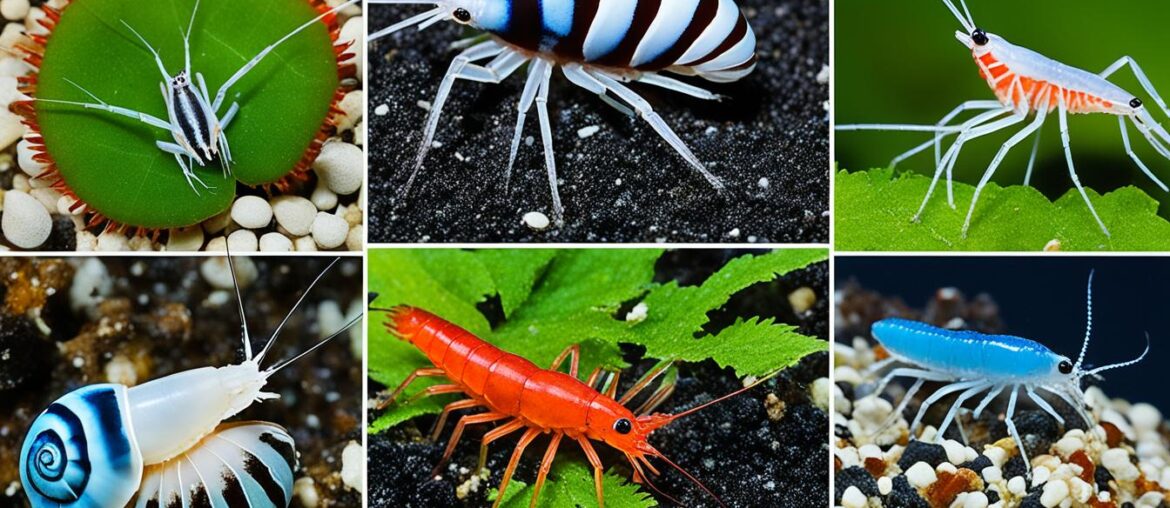Are you a beginner aquarium enthusiast looking to add life and personality to your tank? Look no further! In this article, I will introduce you to the top 5 best freshwater invertebrates that are perfect for beginners. These easy-to-care-for creatures will not only beautify your aquarium but also provide a fascinating glimpse into the world of aquatic life.
From vibrant shrimp to intriguing crayfish and crabs, these beginner-friendly aquarium invertebrates are a great choice for those new to the hobby. With their low maintenance requirements and charming behaviors, they are sure to captivate both you and your guests. But which ones are the most suitable for your tank? Let’s dive in and find out!
Key Takeaways:
- Adding freshwater invertebrates to your aquarium can enhance its beauty and provide unique interactions.
- Shrimp, crayfish, and crabs are popular choices for beginners due to their ease of care and low maintenance requirements.
- Amano shrimp, Cherry shrimp, and Crystal Red shrimp are among the top choices for beginner aquarium enthusiasts.
- Dwarf crayfish and Electric Blue crayfish offer different options for those interested in keeping crustaceans.
- Aquarium snails can also be a great addition, but certain species require careful consideration to avoid overpopulation.
“`
Intriguing question: “Which freshwater invertebrates are the best fit for a beginner’s aquarium? Are you ready to explore the top 5 options?”
Shrimp
Shrimp are a great choice for beginner aquarium enthusiasts. There are many species of shrimp that are very easy to keep and have a low bioload, meaning you can keep them in larger groups. Some popular shrimp species for beginners include Amano shrimp, Cherry shrimp, and Crystal Red shrimp.
Shrimp are known for their vibrant colors and fascinating behavior, making them a delightful addition to any freshwater aquarium. They are highly adaptable and can thrive in a variety of water conditions. Here are some reasons why shrimp make an excellent choice for beginners:
- Easy to keep: Shrimp are generally hardy and can tolerate a range of water parameters. They require minimal care and attention, making them suitable for both novice and experienced hobbyists.
- Low bioload: Shrimp have a small bioload, which means they produce less waste compared to many other aquarium inhabitants. This makes them suitable for smaller tanks and allows you to keep a larger number of shrimp in a single aquarium.
- Beautiful and diverse species: Shrimp come in a wide array of colors and patterns, adding visual interest and vibrancy to your aquarium. From the striking red of Cherry shrimp to the elegant white and black markings of Crystal Red shrimp, there is a shrimp species to suit every aquarist’s taste.
- Algae control: Shrimp are natural algae eaters and can help maintain a clean and healthy tank. They tirelessly graze on unwanted algae, promoting a balanced ecosystem and preventing algae overgrowth.
- Engaging behavior: Shrimp are known for their intriguing behavior, constantly exploring their surroundings and engaging in various activities. Watching them forage, clean their delicate sensory appendages, or interact with their tankmates can provide hours of entertainment and relaxation.
Shrimp are a fantastic choice for beginner aquarists due to their ease of care, low bioload, and captivating beauty. By adding shrimp to your aquarium, you can create a lively and vibrant underwater world that is enjoyable to observe and maintain.
Now let’s take a closer look at some popular species of shrimp that are perfect for beginners:
Amano Shrimp
When it comes to peaceful tropical community tanks and keeping the aquarium clean, Amano shrimp are a fantastic choice. These shrimp are larger than their dwarf counterparts and can thrive in a variety of tank setups.
Amano shrimp are known for their excellent cleaning abilities, making them a valuable asset as part of your tank’s clean-up crew. They have a voracious appetite for leftover foods and unwanted algae, keeping your aquarium in pristine condition. They can effectively control algae growth, reducing the need for manual cleaning and ensuring a healthier environment for your fish.
Popular among aquascapers, Amano shrimp are often kept in groups of at least five to create a visually appealing display. Their peaceful nature allows them to coexist harmoniously with other tropical community fish species, making them an ideal addition to a peaceful aquarium.
Amano shrimp are low maintenance and do not have strict water parameter requirements. They can adapt to a wide range of water conditions, making them suitable for beginner aquarists. Whether you’re a seasoned hobbyist or just starting out, Amano shrimp are a great choice to introduce to your aquatic ecosystem.
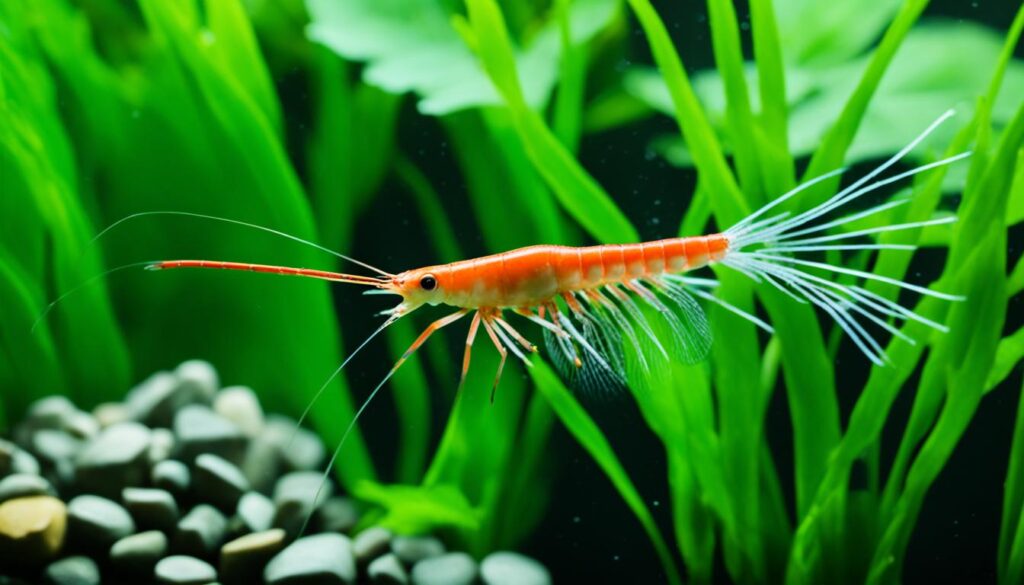
Cherry Shrimp
Cherry shrimp are among the most popular shrimp species for beginners. They are easy to keep, colorful, and breed easily. A tank of 5 gallons or more is enough for a colony to thrive. It’s important to provide hiding places if they share an aquarium with more aggressive fish. Cherry shrimp make a great option for aquarists looking for their first breeding project.
If you’re a beginner aquarium enthusiast, you can’t go wrong with cherry shrimp. These delightful invertebrates are not only visually appealing but also incredibly resilient and low-maintenance. With their vibrant red coloration, cherry shrimp add a pop of color to any aquarium, creating a lively and captivating environment.
One of the reasons why cherry shrimp are so loved by beginners is their ease of care. They are easy to keep and adaptable to various water conditions, making them suitable for a wide range of aquarium setups. As long as you provide them with clean water, a suitable temperature (around 70-78°F), and a well-established filtration system, cherry shrimp will thrive.
Another advantage of cherry shrimp is their ability to breed easily. If you’re interested in witnessing the fascinating life cycle of these incredible creatures, cherry shrimp make an excellent choice. They reproduce rapidly, and with the right conditions, you’ll soon have a thriving colony in your aquarium.
When it comes to tank size, a minimum of 5 gallons is recommended for cherry shrimp. However, a larger tank could provide more stability for the colony. Additionally, it’s essential to ensure that there are ample hiding places, such as plants or decorations, especially if you have other more aggressive fish in the aquarium.
Tips for Keeping Cherry Shrimp:
- Provide a well-established, cycled aquarium
- Maintain clean water conditions
- Ensure the correct temperature range (70-78°F)
- Add hiding places like plants and decorations
- Feed a variety of foods, including algae-based and high-quality shrimp pellets
Cherry Shrimp Tank Setup:
| Parameter | Ideal Range |
|---|---|
| Temperature | 70-78°F |
| pH level | 6.5-7.5 |
| Ammonia | 0 ppm |
| Nitrites | 0 ppm |
| Nitrates | Below 20 ppm |
| Water hardness | 6-10 dKH |
With their vibrant colors, ease of care, and breeding capabilities, cherry shrimp are an excellent addition to any aquarium, whether you’re a beginner or an experienced aquarist. Watching these small shrimp scuttle around and interact with their environment is a joy in itself. So why not dive into the fascinating world of cherry shrimp and create a beautiful ecosystem within your own aquarium?
Crystal Red Shrimp
Crystal Red shrimp are a highly sought-after and beautiful addition to any aquarium. Their stunning coloration makes them a popular choice among aquarists. Fortunately, they are also relatively easy to keep, especially when compared to other varieties of Caridina cf. cantonensis.
One important factor to consider when keeping Crystal Red shrimp is the quality of the water. These shrimp require clean water to thrive. Regular water changes and careful monitoring of water parameters are essential to maintain a healthy environment for them.
Additionally, it is crucial to have a cycled aquarium before introducing Crystal Red shrimp. A cycled aquarium means that the beneficial bacteria have established a colony and can effectively break down harmful substances such as ammonia and nitrites. This ensures a stable and safe environment for the shrimp.
Crystal Red shrimp can be kept in a dedicated shrimp tank or in a community tank with non-aggressive tankmates. However, it’s important to note that they prefer a calm and peaceful environment. Avoid housing them with aggressive or territorial species that may harm or stress the shrimp.
Lower grade Crystal Reds are usually hardier than high-grade ones. It’s a good idea to start with lower-grade shrimp if you are new to keeping Crystal Reds. They will be more forgiving to any beginner mistakes and provide valuable learning experiences.
To learn more about Crystal Red shrimp care and breeding, refer to the table below for a summary of their requirements:
| Parameter | Requirement |
|---|---|
| Water Temperature | 72-78°F (22-26°C) |
| pH Level | 6.2-7.4 |
| Water Hardness (GH) | 6-8 dGH |
| Ammonia and Nitrites | 0 ppm |
| Nitrates | |
| Tank Size | 5 gallons or more |
Note: These parameters are general guidelines and may vary slightly depending on your specific setup. Always monitor the water parameters and make adjustments if necessary.
Overall, Crystal Red shrimp are a fascinating and rewarding species to keep. With proper care and attention to water quality, these beautiful shrimp can thrive in your aquarium and become a captivating centerpiece.
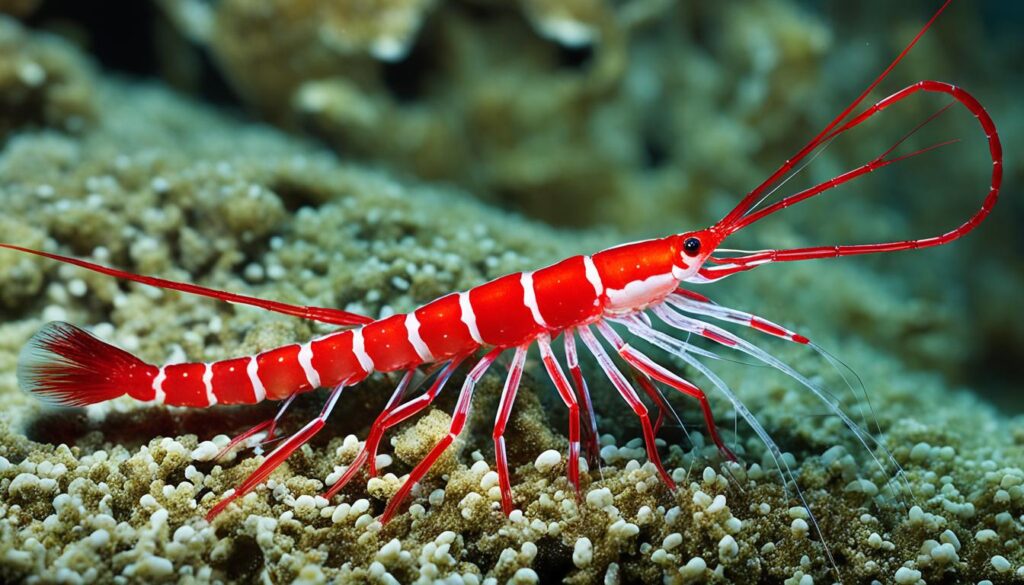
Dwarf Crayfish
When it comes to adding some unique and interesting creatures to your aquarium, dwarf crayfish are an excellent choice. These small crustaceans are smaller versions of regular crayfish and are loved by aquarists for their peaceful nature. Not only are they beautiful to look at, but they also contribute to the overall balance of your tank.
Dwarf crayfish are known to get along well with many non-carnivorous tankmates, making them great additions to community tanks. They are generally peaceful and won’t cause any harm or aggression towards other fish or invertebrates. However, it’s always important to monitor their behavior and ensure the tankmates are compatible to maintain a harmonious environment.
“Dwarf crayfish are the perfect inhabitants for creating an engaging and diverse ecosystem in your aquarium. Their interesting behavior and peaceful nature make them a delight to observe.”
A small 8-gallon aquarium is usually sufficient to accommodate 2-3 dwarf crayfish. However, they are also adaptable and can be kept in larger tropical community tanks as long as they’re not combined with significantly larger fish that may perceive them as prey. Providing plenty of hiding places and a well-decorated tank with plants and caves will create the perfect environment for them to thrive.
| Type | Minimum Tank Size | Compatible Tankmates |
|---|---|---|
| Dwarf Crayfish | 8 gallons | Many non-carnivorous tankmates such as tetras, danios, guppies, and small catfish. |
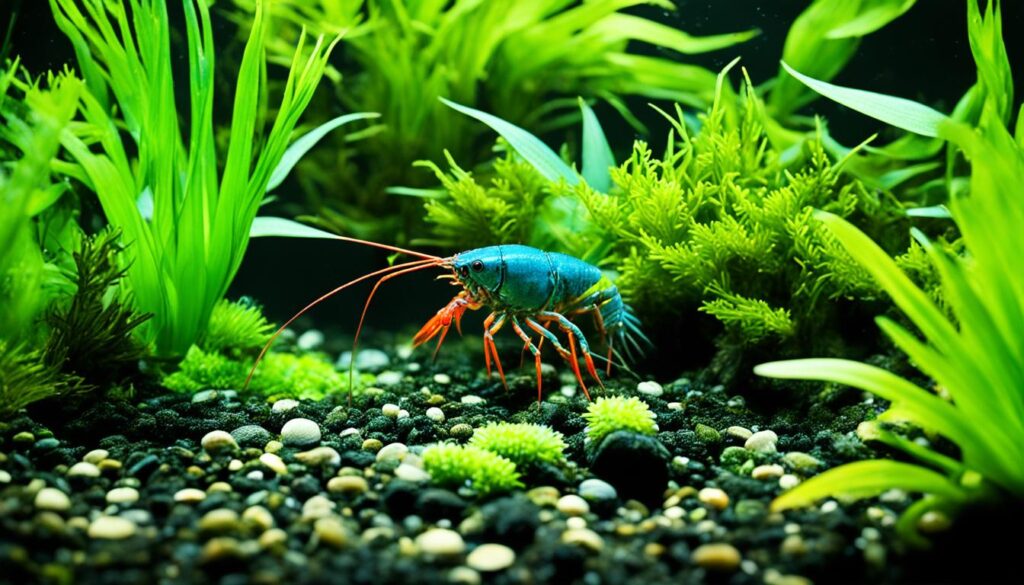
Add some dwarf crayfish to your aquarium, and you’ll have an exciting and peaceful addition that will capture the attention of anyone who sees them. They are charming creatures that will bring life and character to your underwater world.
Electric Blue Crayfish
When it comes to freshwater invertebrates, Electric Blue Crayfish are a captivating and popular choice for aquarium enthusiasts. These crayfish are not only visually stunning with their vibrant electric blue coloration but also exhibit fascinating behaviors that make them a delight to observe. However, it’s important to understand their specific care requirements to ensure their well-being in your aquarium.
One notable characteristic of Electric Blue Crayfish is their size and temperament. Unlike their smaller counterparts, these crayfish can grow quite large and tend to be more aggressive. Therefore, it is essential to provide a larger aquarium for them to thrive and prevent any conflicts with tankmates.
Size and Aggression
Electric Blue Crayfish can reach a size of up to 6 inches (15 centimeters) in length, making them significantly larger than dwarf crayfish. Due to their size and territorial nature, they require a larger tank that provides ample space for them to roam and establish their territories. A minimum tank size of 20 gallons is recommended to accommodate their size and aggression.
When keeping Electric Blue Crayfish with other fish, it’s crucial to choose peaceful species that can withstand their aggressive nature. Additionally, providing plenty of hiding places, such as caves, rocks, and plants, will help create territories and reduce potential conflicts.
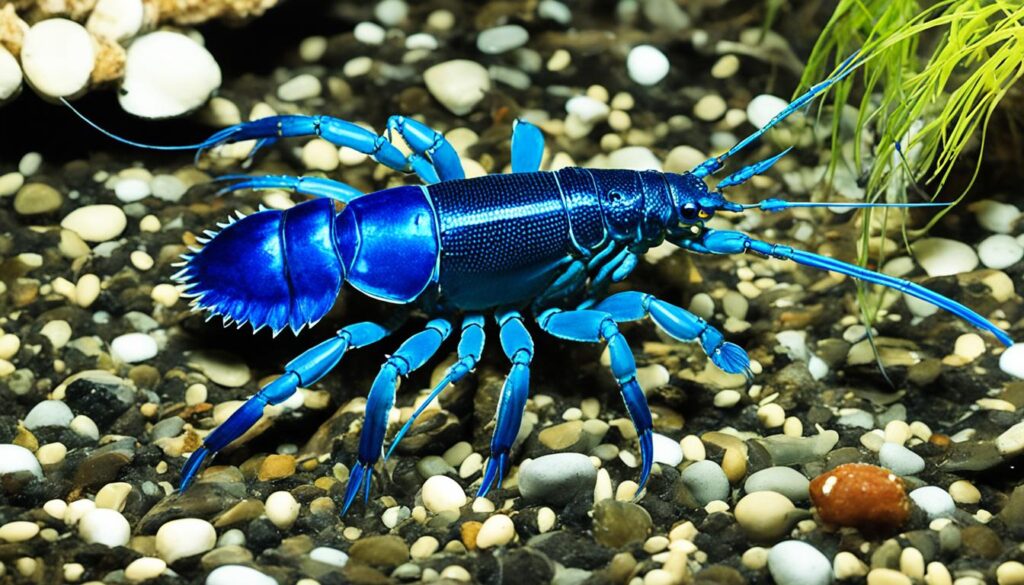
Care Considerations
Electric Blue Crayfish require similar water parameters as other crayfish species. They thrive in a temperature range of 65-75°F (18-24°C) and prefer a neutral to slightly alkaline pH level around 7.5. It’s essential to regularly monitor the water quality and perform necessary water changes to maintain optimal conditions for their health.
These crayfish are omnivorous, feeding on a variety of foods including pellets, flakes, and frozen or live foods. It’s recommended to provide a well-balanced diet consisting of both plant matter and protein-rich food sources to ensure their nutritional needs are met.
| Care Considerations for Electric Blue Crayfish | |
|---|---|
| Water temperature | 65-75°F (18-24°C) |
| pH level | Neutral to slightly alkaline (around 7.5) |
| Tank size | Minimum 20 gallons |
| Compatibility | Choose peaceful tankmates |
| Diet | Varied diet with plant matter and protein-rich foods |
Creating a stimulating environment for Electric Blue Crayfish is essential to promote their well-being. Adding a variety of decorations, such as rocks, driftwood, and live plants, can provide hiding spots and enrichment opportunities for them to explore.
Ultimately, setting up a dedicated tank for Electric Blue Crayfish allows you to fully appreciate their stunning coloration, unique personalities, and captivating behaviors. With the right care and environment, these crayfish can be a fascinating addition to your freshwater aquarium.
Crabs
When it comes to aquarium invertebrates, crabs can be a fascinating addition. However, caring for aquarium crabs can be more challenging compared to shrimp and crayfish. Many crab species require a more complicated setup that includes access to land and, in some cases, brackish water.
One popular choice among aquarium hobbyists is the Red Claw Crab. These crabs need a paludarium setup, which provides both water and land areas. This allows them to exhibit their natural behaviors and explore their surroundings. However, it’s important to carefully balance the water-to-land ratio to ensure their well-being.
Another option for crab enthusiasts is the Thai Micro Crab. Unlike some other crab species, Thai Micro Crabs are fully freshwater creatures, making them suitable for smaller tanks. They are known for their vibrant colors and small size, which adds a unique charm to any aquarium.
Here is a comparison between Red Claw Crabs and Thai Micro Crabs:
| Red Claw Crabs | Thai Micro Crabs |
|---|---|
| Requires a paludarium setup with both water and land areas | Can be kept in a smaller freshwater tank |
| Prefer brackish water | Thrives in freshwater conditions |
| Compatible with some fish species | Best kept with peaceful tankmates like shrimp |
Both Red Claw Crabs and Thai Micro Crabs have their own unique care requirements, and it’s important to research and provide the appropriate environment for them to thrive.
While aquarium crabs can be more challenging to care for, the rewards of observing their behavior and unique characteristics make them a worthwhile addition to any aquatic setup.
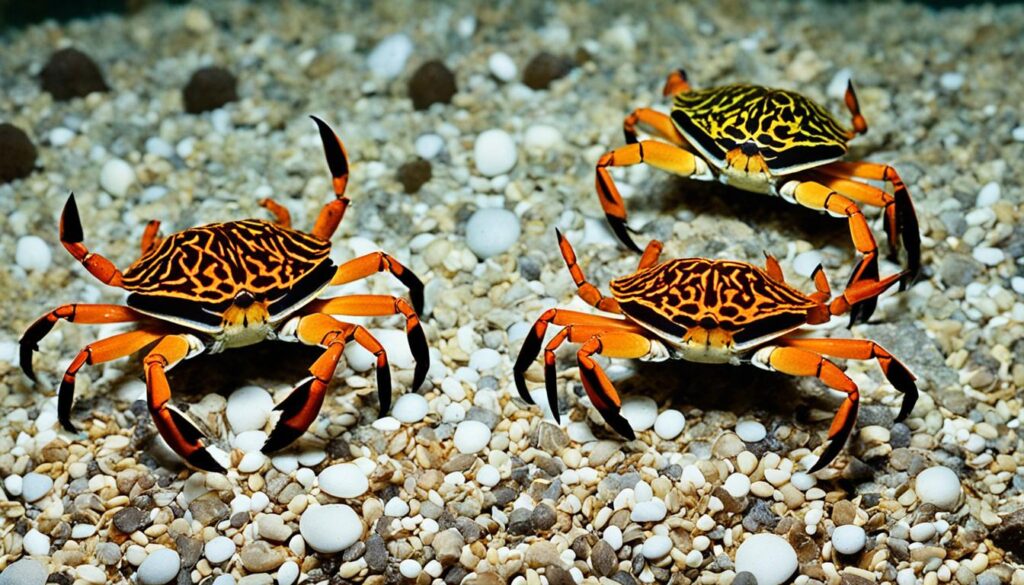
Red Claw Crabs
Red claw crabs are fascinating creatures that require a specialized setup in your aquarium. Unlike fully aquatic species, these crabs need a paludarium that provides access to both land and water. Ensuring the right environment is crucial for their health and well-being.
To create a suitable paludarium setup for red claw crabs, you’ll need to consider a few important factors. The aquatic part of the tank should have a salinity of around 1.005, which is slightly brackish. This level of salinity mimics their natural habitat and promotes their overall health. Additionally, the water level should be at least 6 inches to allow them enough space to swim and move around comfortably.
It’s important to note that red claw crabs are omnivores and have diverse dietary needs. They will happily accept a variety of foods, including both plant matter and animal protein. Providing a balanced diet is crucial for their nutrition and overall well-being.
One thing to be mindful of when keeping red claw crabs is their natural ability to escape. These crabs are known to be skilled escape artists, so special precautions should be taken to prevent them from finding their way out of the tank.
In summary, red claw crabs are unique invertebrates that require a paludarium setup with access to land and slightly brackish water. It’s important to maintain the appropriate salinity and water level to ensure their health. With the right care and attention, these fascinating creatures can thrive in your aquarium.
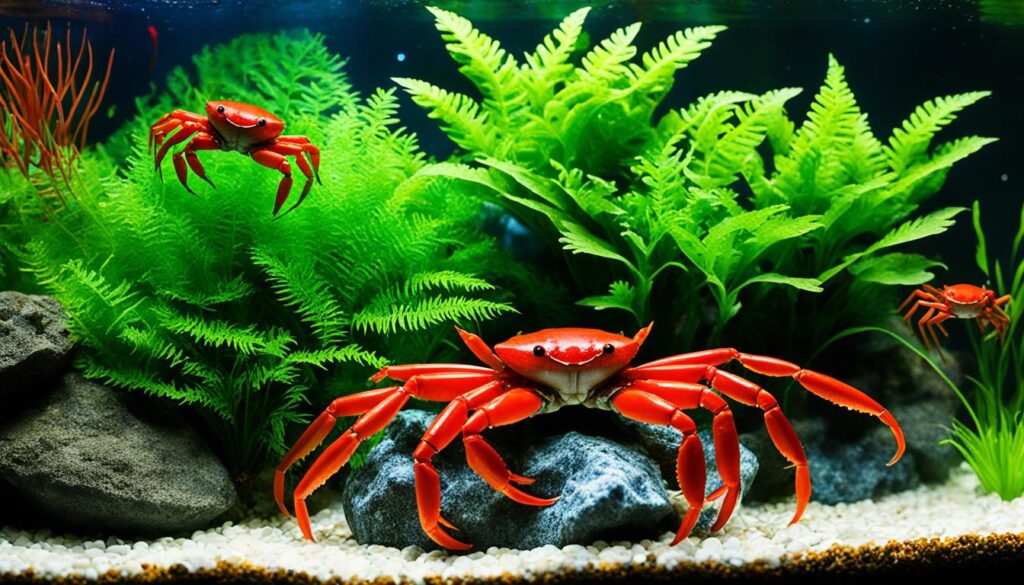
| Red Claw Crabs Care Summary | |
|---|---|
| Setup | Paludarium with access to land and water |
| Water Salinity | Approximately 1.005 (slightly brackish) |
| Water Level | At least 6 inches |
| Diet | Omnivorous – Variety of plant matter and animal protein |
| Escape Prevention | Secure tank setup to prevent escapes |
Thai Micro Crabs
When it comes to unique and fascinating freshwater invertebrates, Thai micro crabs are a standout option. These small crustaceans offer a captivating addition to your aquarium, with their intricate appearance and interesting behavior.
Thai micro crabs are fully freshwater creatures, making them suitable for smaller tanks. In many ways, they are similar to dwarf shrimp, both in terms of their care requirements and their peaceful temperament. They prefer a calm and tranquil environment, making them excellent tankmates for other peaceful species.
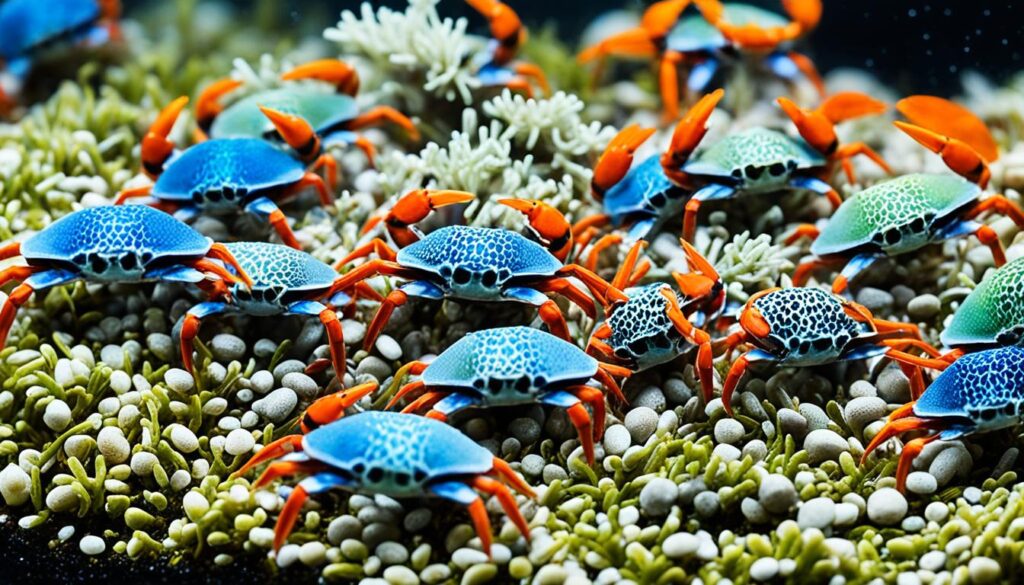
Breeding Thai micro crabs in a home aquarium is possible, although it can be a challenging endeavor. These crabs have specific needs when it comes to water parameters and food, so providing the ideal conditions for successful breeding can take time and effort.
It’s worth noting that Thai micro crabs can be vulnerable, especially when kept with larger or more aggressive tankmates. For their safety and well-being, it is best to keep them alone or in the company of peaceful species like shrimp.
Aquarium Snails
Aquarium snails can be a valuable addition to any beginner’s aquarium. They serve as efficient cleaners, munching on algae and leftover food, helping to maintain a healthy and balanced ecosystem. Additionally, some snail species have an intriguing behavior of burrowing in the substrate, adding an extra layer of interest to your tank.
However, it’s crucial to be mindful of certain snail species that have a high reproductive rate and can quickly overrun the aquarium. The Malaysian trumpet snail, for example, has a reputation for multiplying rapidly under suitable conditions. To prevent your tank from being overrun, it’s essential to choose snail species that are compatible with your aquarium setup and won’t become a nuisance.
In order to match the needs of your aquarium, consider the following characteristics when selecting snails:
- Compatibility with tankmates: Some snail species may be more aggressive and can harm or be harmed by other tank inhabitants. Research the compatibility of snail species with the other fish, shrimp, or invertebrates you plan to keep in your aquarium.
- Size: Snail species vary in size, with some growing larger than others. Ensure that the size of the snail fits well with the available space in your aquarium.
- Reproduction rate: Certain snail species reproduce quickly and can quickly populate the tank. If you want to avoid the risk of an overpopulation, choose snail species with a lower reproductive rate.
- Feeding habits: Different snail species have varying preferences when it comes to food. Some species may primarily eat algae, while others may require additional food sources. Consider the availability of food and the compatibility with other inhabitants in your aquarium.
By selecting the right snail species for your aquarium and understanding their behaviors and requirements, you can enjoy the benefits they bring while ensuring a harmonious and balanced aquatic environment.
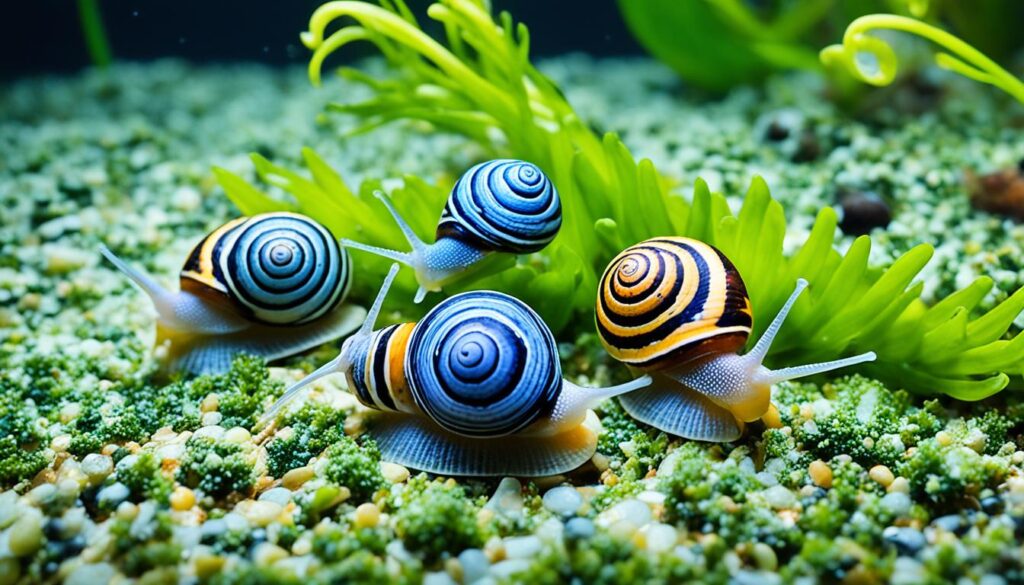
| Snail Species | Size | Reproduction Rate | Feeding Habits |
|---|---|---|---|
| Mystery Snail | 2-3 inches | Low | Algae, leftover food |
| Nerite Snail | 0.5-1 inch | Low | Algae |
| Rabbit Snail | 2-5 inches | Moderate | Algae, detritus |
| Assassin Snail | 1 inch | Low | Preys on other snails |
Conclusion
In conclusion, freshwater invertebrates offer a wide range of options for beginners’ aquariums. Shrimp, crayfish, and crabs are all excellent choices due to their ease of care and low maintenance requirements. However, it’s crucial to research each species thoroughly to understand their specific needs and provide the appropriate habitat and tankmates.
By acquiring the right knowledge and preparing adequately, enthusiasts can enjoy the beauty and benefits of these fascinating invertebrates in their aquariums. Whether it’s the vibrant colors of Amano shrimp, the breeding potential of Cherry shrimp, or the captivating behavior of dwarf crayfish, there is an ideal freshwater invertebrate for every aquarist.
Remember to cultivate a peaceful environment, select compatible tankmates, and ensure proper water conditions. With dedication and a genuine passion for these invertebrates, anyone can create a thriving aquatic ecosystem that brings joy and tranquility to their home.
FAQ
What are the best freshwater invertebrates for beginners?
The best freshwater invertebrates for beginners include shrimp, crayfish, crabs, and snails.
What are some popular shrimp species for beginners?
Popular shrimp species for beginners include Amano shrimp, Cherry shrimp, and Crystal Red shrimp.
Can Amano shrimp be kept in community tanks?
Yes, Amano shrimp are suitable for peaceful tropical community tanks.
What role do Amano shrimp play in the aquarium?
Amano shrimp are effective as a clean-up crew, helping to remove leftover foods and eat unwanted algae.
Are Cherry shrimp easy to keep?
Yes, Cherry shrimp are easy to keep and breed easily.
How big of a tank do Cherry shrimp need?
A tank of 5 gallons or more is enough for a Cherry shrimp colony to thrive.
Are Crystal Red shrimp easy to keep?
Yes, Crystal Red shrimp are easier to keep than many other Caridina cf. cantonensis varieties, but they still require clean water and a cycled aquarium.
Can dwarf crayfish be kept with other fish?
Yes, dwarf crayfish can be kept with many non-carnivorous tankmates.
How many dwarf crayfish can be housed in an aquarium?
An 8-gallon aquarium can house 2-3 dwarf crayfish.
Can electric blue crayfish be kept with other fish?
Yes, electric blue crayfish can be kept with other fish but need plenty of hiding places.
Do aquarium crabs need access to land?
Yes, many crab species require a more complicated setup with access to land.
Can Red Claw crabs be kept in a paludarium setup?
Yes, Red Claw crabs need a paludarium setup with both water and land areas.
Can Thai micro crabs be kept in freshwater?
Yes, Thai micro crabs are fully freshwater and can be kept in smaller tanks.
Can aquarium snails eat algae?
Yes, aquarium snails can eat algae and leftover foods.
Do certain snail species reproduce quickly?
Yes, certain snail species like the Malaysian trumpet snail can reproduce quickly and overrun the tank.
